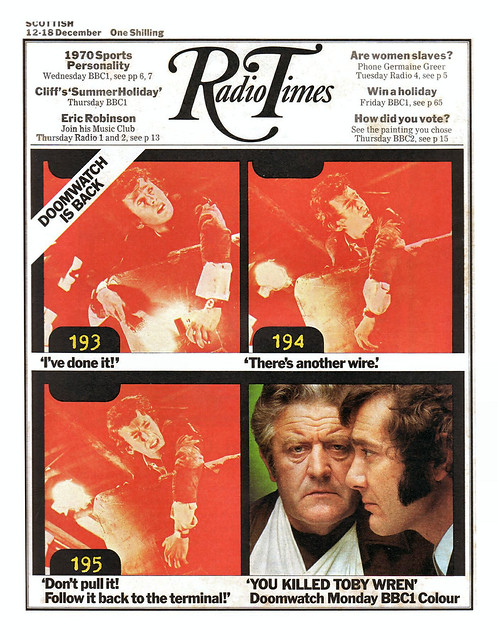
This edition of Radio Times dates back to 1970 and on the cover the classic series, Doomwatch. Doomwatch was a British Science Fiction Television programme produced by the BBC, which ran on BBC One between 1970 and 1972. The series was set in the then present-day, and dealt with a scientific government agency led by Doctor Spencer Quist (played by John Paul), responsible for investigating and combating various ecological and technological dangers.
The series was followed by a film adaptation produced by Tigon British Film Productions and released in 1972, and a revival TV movie broadcast on Channel 5 in 1999.
The programme was created by Gerry Davis and Kit Pedler, who had previously collaborated on scripts for Doctor Who, a programme on which Davis had been the story editor and Pedler the unofficial scientific adviser during the 1960s. Their interest in the problems of science changing and endangering human life had led them to create the popular alien race the Cybermen for that programme, and it was similar interests that led them to create Doomwatch, which explored all kinds of new and unusual threats to the human race, many bred out of the fear of real scientific concepts, with a "this could happen to us" fear by the public.
In the story, the actual name of the organisation was "Department for the Observation and Measurement of Scientific Work". Officially Doomwatch was an agency dedicated to preserving the world from dangers of unprincipled scientific research - "We were set up to investigate any scientific research, Public or Private, which could possibly be harmful to Man" - but the real intention was to form a body with little power meant to stifle protests and secure green votes. However the incorruptible Dr Spenser Quist and companions soon gave the agency some real power and people had to listen.
Quist had worked on the development of the atomic bomb and seen his wife die of radiation poisoning; Ridge was the secret agent type and Wren a conscientious researcher. Together they took science into people's living rooms, explaining about embryo research, subliminal messages, wonder drugs, dumping of toxic waste, noise pollution, nuclear weaponry, animal exploitation, etc.
There were other storylines such as genetic mutation creating a particularly large and vicious race of rats, and a virus that ate away at all types of plastics causing aeroplanes to fall out of the sky. There were also everyday stories like when Dr. Quist turned up at a meeting and was thought to be drunk but turned out to have severe jet lag. However, after Davis and Pedler left the show at the conclusion of the second series in 1971, it turned into a more conventional thriller drama, which the two creators openly criticised.
The first two series each consisted of thirteen episodes, and the third of twelve, of which one - titled Sex and Violence and intended to be shown as the fifth episode - was not transmitted. It has been suggested that this was because of objections to either its use of stock news footage of a public execution in Lagos, or its presentation of characters designed to be satirical analogues of Mary Whitehouse, Cliff Richard and Lord Longford. The execution footage has appeared on British television a number of times since the 1972, notably in a 1988 edition of Panorama about violence on television.
The programme was very popular and drew audiences of as high as 13.6 million at its peak for an episode called Invasion, filmed mostly in the village of Grassington in Yorkshire. The start of every series merited a cover feature on the BBC's Radio Times listings magazine, which even today is a prestigious feat for a programme. The show was also sold abroad, gaining some popularity when transmitted in Canada.
As was common at the time, the BBC wiped the Doomwatch master tapes soon after transmission, regarding them to be of little further use. Although some episodes have been returned from Canada or exist as telerecordings, many are still missing and will likely remain so, although all are being sought by the BBC Archive Treasure Hunt as a whole. However, a copy of the unbroadcast episode survives in the archives, one of only three from the final series to do so. Thanks to the Canadian returns series two is complete, but series one is missing five shows. Some of the existing episodes have had a limited release on VHS and DVD in the UK, and all - except Sex and Violence - were repeated on the satellite channel UK Gold during the 1990s, although that episode was erroneously scheduled.
Pedler and Davis re-used the plot of the first episode of the series, The Plastic Eaters, for their 1971 novel Mutant 59: The Plastic Eater, although this was not officially a Doomwatch novel and did not contain the characters from the series. The book also re-used the Radio Times cover photograph of a melted plastic aeroplane in a briefcase.
